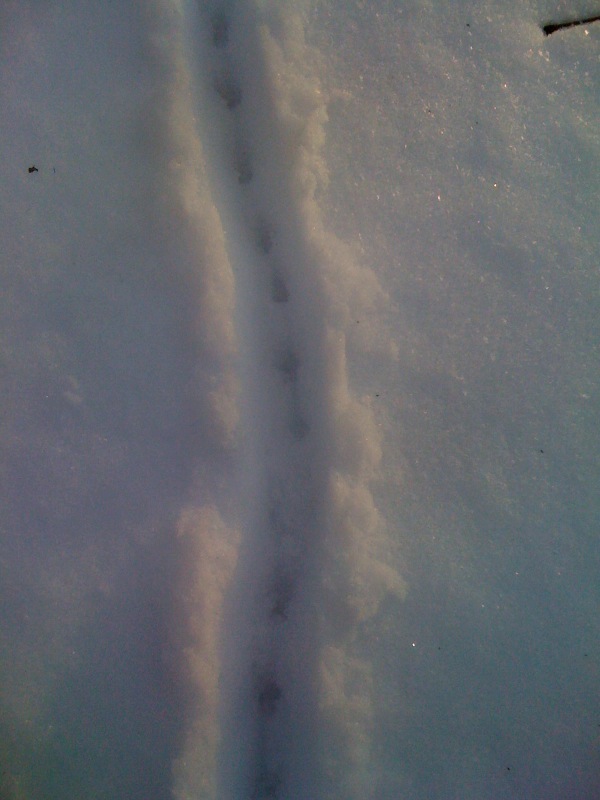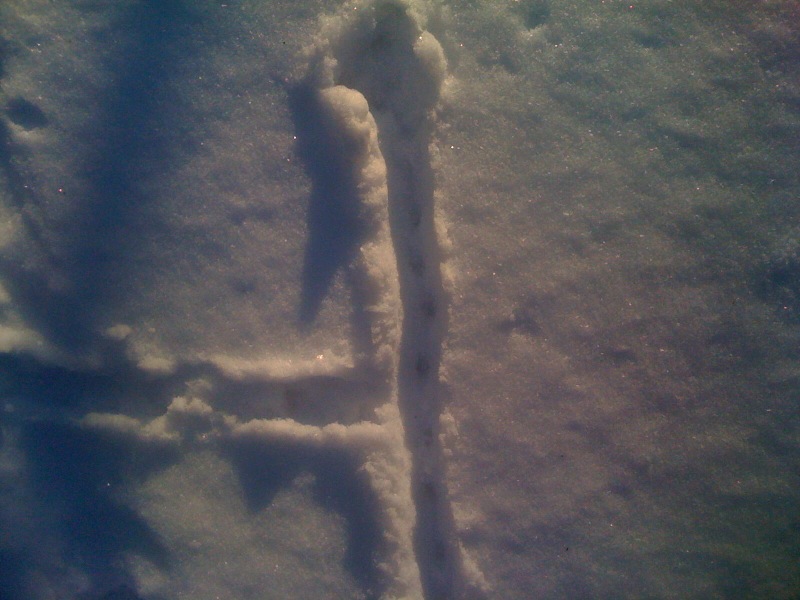Track Identification Challenge
When it snows, I can hardly wait to get out to the woods or to other natural areas just to see the record left by different critters as tracks. For instance, yesterday at the Overland Park Arboretum I was wishing I had my normal camera along to record some of the tracks. I saw bobcat tracks trailing along downed logs, coyote tracks on the ice and countless deer tracks.
Here’s a challenge—I finally remembered that I had my iPhone camera with me and recorded some very unusual tracks that I’m going to put out as an i.d. challenge. I apologize for the quality of the iPhone camera. I will tell you that occasionally these tracks would dive below the snow and they seemed to go all over the place. Also the width of the track groove was just over an inch. If my i.d. is correct these tracks were found in an atypical habitat for this species—in an open woodland of large willow shingle and white oaks with flower beds. Here’s the images—let’s have your analysis:
Final photo:




Those are not my tracks.
I con my students to follow me around doing lots of things but I don’t think many would have been up for such an activity before school officially starts back up.
It was too cold, yesterday for shrews on the surface–I imagine they prefer the subnivian habitat on such days. Still, I stopped by the arboretum to check out the tracks and the bird feeding stations. No shrew tracks (or reasonable facsimiles) but there were a number of off-trail human tracks in the area. Did you our your students get out there Eric?
I did look for a tail drag—it’s one of the first things I look for. It wasn’t there. It is sometimes apparent on mice and such when they are on top of the snow. In this case though, the critter was plowing through the snow. A short-tail shrew’s tail is both short and thin relative to almost every other critter that size. Only voles and bog lemmings have smaller tails. I have seen Blarina leave marks but only under perfect conditions–it’s more of a scuff and not a drag. (Could have had those conditions when we got the additional snow but I wasn’t out there then.) Blarina carolinensis occurs throughout the state and is relatively common. A couple of years ago I found 5 on my running route in just one week (all dead). Cats have a tendency to kill these and not eat them. Here’s the coordinates for the photos:
38.801039, -94.690081
In taking the time to look for the caption to the image link I posted, I discovered that all those tracks were not from “Blarina” although that is what I had google image searched (blarina tracks).
As the caption says, they are, from left to right, from Blarina in the snow, Deermouse, Meadow Mouse, and Masked Shrew.
It was a question though not a statement and asked based on the evidence I had at hand. As you will still see along the beginning of the Blarina track sketch that I posted, there is still a line between the first four foot prints (assumed to be produced by a tail and not dragging of the feet in some manner – and assuming that the sketch was done by a credible observer).
Are you sure your observations (memory) aren’t being clouded by your expectations based on the common name of the animal?
I think short in this case is a relative term. The images I find using google suggest that this animal could potentially produce a tail line. Wiki says the tails range from 0.7 to 1.3 inches in length.
http://en.wikipedia.org/wiki/Northern_Short-tailed_Shrew
Thus, how could a 1.3 inch tail not make a mark in the snow?
Give me the GPS coordinates and I’ll give my students an assignment to find evidence that short-tailed shrews can produce a tail line as well. : )
You aren’t going to see a tail line on a Blarina—they are called short-tailed shrews for a reason.
The best evidence would be a image of a shrew in the act of making the tracks…
Could you see the tail drag line? Here is a link I found from the Boy Scout Handbook with some shrew track images, and they all suggest that a tail drag line should be evident. http://www.gutenberg.org/files/29558/29558-h/images/p0198pic1.jpg
The link you posted was nice too (I finally got a flicker account). Makes me what to get out there and see what I can find. Well, maybe once the temperature rises a little bit…
Good hypothesis, Eric……any ideas of other evidence that would help you be more certain?
I have to agree, based on these images. In fact, based on the size and all, I would say this is a Blarina sp.
btw, Shrews are plantigrade (flat-footed).
Here’s a link to some purported shrew tracks form Ontario. He suggests they are shrew tracks–again a good hypothesis. If you look through Ontario Wanderer’s photostream you’ll note that he is learning his tracks too. (Just search on tracks.)
After your hints on size and consulting Murie’s Peterson’s Field Guide to Animal Tracks, I imagine that it is a SHREW of some sort. Here are some comments from the field guide that match your photos/hints…
“You will seldom find shrew tracks except in snow”… “The shrew trail will measure about 1 inch in width”… “In soft snow the shrew has a habit shared by several other mammals. It will dive in and travel under the snow.”
No attempts at the challenge? Hmmm….. perhaps another hint…..
There were other tracks that I did not photograph—in a tell-tale 2 x 2 pattern–that mostly eliminates the mouse possibilities. This is one neat critterfor NE KS. BTW, I went back out to the Arboretum, yesterday and the network of track sign now covers about 1.5 acres.